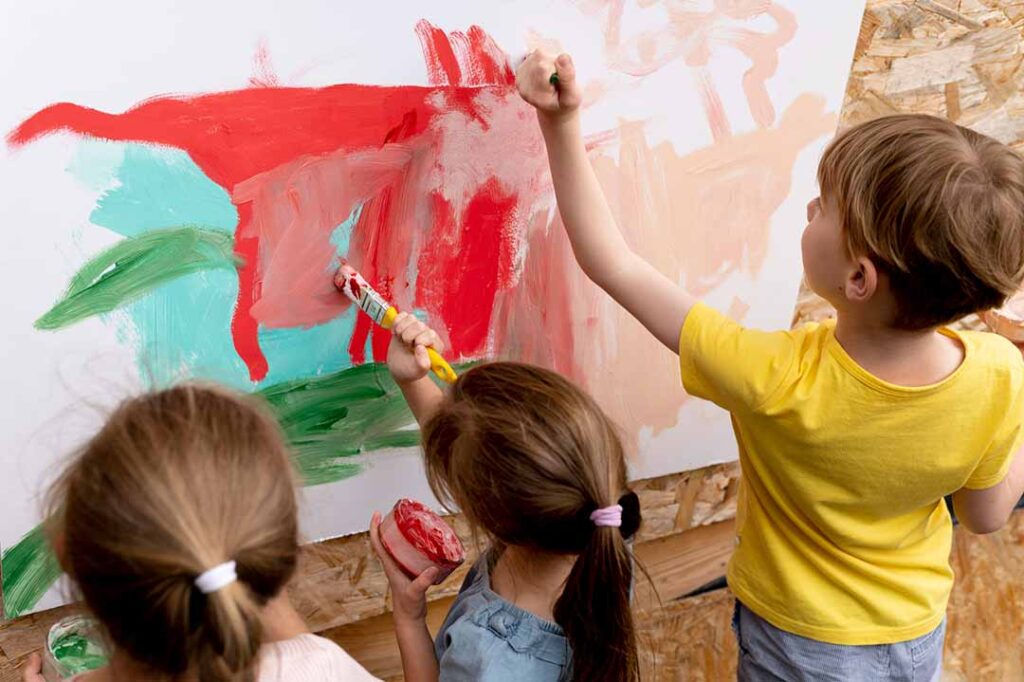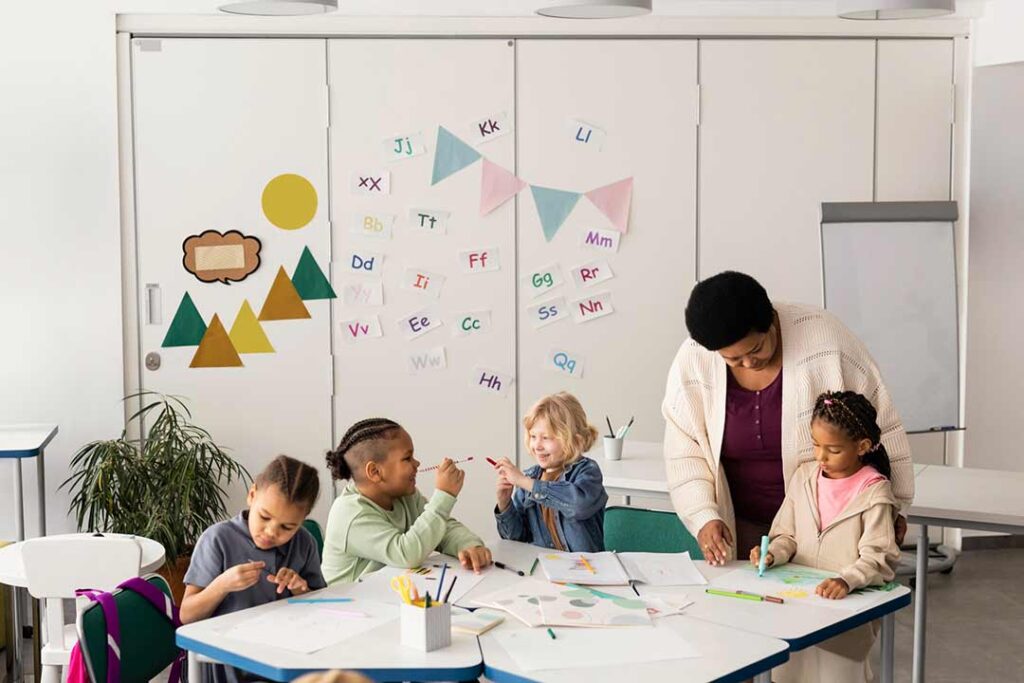- [email protected]
- +353 (0)86 224 0139
- Free Shipping Worldwide
Benefits of Art for Kids: Unlock Their Creative Potential
Discover the transformative benefits of art for kids. Nurture imagination, self-expression, and problem-solving skills. Empower your child's growth through artistic exploration. Experience the joy of creativity today!
Reading Time: 15 minutes
TL;DR
- Discover the importance of creativity in children.
- Learn how to encourage creativity in kids.
- Explore the benefits of art education.
Introduction: The Benefits of Art for Kids in their Development
Art is often seen as an enjoyable pastime for children, holds a deeper significance beyond the vibrant colours and whimsical shapes. It is more than just a splash of paint on canvas or a handful of clay moulded into figures.
Art is a powerful tool that nurtures creativity, stimulates imagination, and fosters emotional development in children.
In this blog post, we delve into the myriad benefits of art for kids. Through their education and parenting, from ways to promote creativity in children, enhancing critical thinking skills to boosting academic performance and beyond.
Art Stimulates Imagination and Creativity
Imagination and creativity are two essential ingredients in the recipe of innovation. Art provides children with a platform to express these innate abilities.
When a child is given a blank canvas, they are not simply presented with a white space to fill; they are given an opportunity to create worlds, to tell stories, and to express their thoughts and ideas in a way that words sometimes fail to capture.
Each stroke of their brush or each fold in their paper fuels their creative engine, encouraging them to visualize and create something unique.
How Does Art Help Children’s Creativity?
Art has a magical way of nurturing and enhancing the creativity of children. It serves as a powerful tool in their development, allowing them to explore and express their innermost thoughts and emotions.
Creative activities allow children to think outside the box, to imagine new possibilities and to embrace their unique perspectives.
How to Nurture a Child’s Creativity
Engaging in artistic activities enables children to tap into their imagination and unleash their creative potential. It provides them with a safe space where they can freely experiment with colours, shapes, textures and materials.
Art stimulates a child’s ability to transform abstract thoughts into tangible form. This process of creation develops a child’s creative thinking and problem-solving skills, equipping them with the ability to think outside the box, to generate new ideas, and to find innovative solutions to problems.
Art Teaches Critical Thinking and Problem Solving
Art is not always about creating a beautiful masterpiece. Sometimes, it is about facing challenges and finding solutions.
When a child engages in artistic pursuits, they may encounter various obstacles. For example, a piece of clay that just will not mould quite right, a colour that refuses to blend the way they want it to, or a sketch that doesn’t quite match their vision.
These challenges push children to think critically and solve problems creatively. Through art, children learn that there is not always one ‘right’ answer or method.
They learn to explore different possibilities, make decisions based on their observations and assessments, and adapt their approach when necessary.
This development of critical thinking and problem-solving skills is invaluable, serving as a stepping-stone to higher-level thinking and learning in all areas of life.
Art Promotes Self-Expression and Emotional Development
For children, art is a language. One that allows them to communicate their feelings, thoughts, and experiences without needing the right words.
Through their artwork, children can express their inner emotions, opening a window into their world that others, including parents and educators, can look into.
Creating art offers children a safe and constructive outlet for their emotions. It helps them understand and express what they are feeling, assisting them in processing complex emotions.
This emotional expression and understanding can lead to better emotional health and improved self-awareness, contributing significantly to a child’s overall well-being.
Developing Crucial Skills Through Artistic Pursuits
Art Improves Focus and Concentration
Whether it is painting a delicate flower with finger paints or moulding a clay sculpture, creating art requires focus and concentration. As children immerse themselves in the process of creating, they develop their ability to concentrate on tasks.
They learn to pay attention to details, to observe their surroundings carefully, and to work patiently towards completing their projects.
This improved focus and concentration can translate into better academic performance and greater productivity in other areas of life. Moreover, the practice of focusing on art can also have calming effects, helping children manage stress and anxiety.
Art Teaches Discipline and Patience
Ask any artist, because after a lifetime of doing it, I have discovered art is not always easy. It often involves trial and error, repeated attempts, and gradual improvements. When children engage in artistic activities, they learn the value of patience and discipline.
They discover that good things take time, and that progress often comes in small steps. This understanding can help them develop a positive attitude towards challenges and setbacks, fostering resilience and perseverance.
Additionally, art teaches children about the importance of commitment and consistency. Whether it is practicing a musical instrument every day or working on a painting over several weeks, children learn that sustained effort and dedication yield results.
This lesson in discipline can be applied to various aspects of their lives, from academics to sports to personal relationships.
Art Boosts Communication and Social Skills
Art can be a powerful communication tool. Through their artwork, children can convey their thoughts, feelings, and experiences, fostering empathy and understanding among their peers.
This expressive aspect of art helps children improve their communication skills, enabling them to share their perspectives and understand others better.
Moreover, engaging in-group art activities promotes cooperation and teamwork. As children work together on a shared project, they learn to listen to others’ ideas, respect differing viewpoints, and collaborate effectively.
These social skills are fundamental for their personal and social development, preparing them for future interactions and relationships.
Encouraging Collaboration and Social Interaction
How Group Art Activities Foster Teamwork and Communication Skills
Collaborative art projects for kids are not just about creating beautiful masterpieces; they also serve as a powerful tool for developing teamwork and communication skills. When children engage in-group art activities, they learn the importance of working together towards a common goal.
Through these collaborative projects, children learn to listen to each other’s ideas, share their own thoughts and opinions, and find creative ways to combine their individual strengths. This fosters a sense of unity and cooperation within the group.
Moreover, as children work together on a piece of artwork, they are constantly communicating with one another – discussing ideas, giving feedback, and problem solving. This helps them improve their communication skills by learning how to express themselves effectively while respecting the perspectives of others.
By engaging in collaborative artwork, children not only develop their artistic abilities but also gain valuable life skills that will benefit them in various aspects of their lives. They learn the power of teamwork and effective communication – qualities that are essential for success in both personal and professional relationships.
So let us encourage our young artists to embark on collaborative art projects that will not only nurture their creativity but also enhance their teamwork and communication skills. Together, they can create wonders!
1. Mural Creation
Mural creation is one example of a group art activity that promotes collaboration and communication skills.

Children collaborate to produce a large-scale painting or artwork on a wall or canvas in this activity. Each child can add their own ideas and artistic flair to the mural, while simultaneously working with others to produce a cohesive and unified piece.
Children must communicate and collaborate with one another throughout the mural-making process. They must debate and organise the general design, choose colours and materials, and assign distinct jobs to each member of the group. This necessitates excellent communication as well as the ability to listen to the thoughts and viewpoints of others.
Furthermore, as children confront issues or conflicts during the mural-making process, they must solve problems and make decisions. They must discover inventive solutions and compromises that satisfy everyone’s preferences while maintaining the mural’s overall design. This assists students in developing critical thinking abilities and learning how to resolve problems constructively.
Children who participate in mural creation not only improve their artistic abilities but also their collaboration and communication skills. They understand the value of teamwork, compromise, and clear communication in attaining a common goal. These abilities can be applied to other aspects of their lives, such as school projects, sports teams, and future employment.
Overall, collaborative art projects such as mural painting give youngsters significant opportunities to collaborate, express themselves creatively, and learn important life skills. They develop teamwork, communication, problem-solving, and decision-making skills that will serve them well throughout their lives.

2. Group Crafting Sessions
Group crafting sessions can be a wonderful way for children to unlock and embrace their creative potential.
Artistic collaboration in a group setting offers countless benefits, not only for fostering creativity but also for promoting social development and building meaningful connections.
When children engage in group crafting sessions, they have the opportunity to exchange ideas, share techniques, and inspire one another.
This collaborative environment encourages them to think outside the box, explore new artistic styles, and experiment with different materials.
It also allows them to learn from their peers, gaining valuable insights and expanding their creative horizons.
Beyond the artistic aspect, group crafting sessions provide a setting for children to develop essential social skills.
As they work together, children learn the importance of communication, cooperation, and compromise. They learn to appreciate different perspectives and find common ground, fostering empathy and understanding.
Moreover, these sessions create a sense of camaraderie and belonging among participants. The shared experience of creating something together cultivates a supportive and inclusive atmosphere where children can feel safe to express themselves and take risks.
This sense of community nurtures their self-confidence and encourages them to explore their creative potential further. Group crafting sessions can take place in various settings, including school classrooms, community centres, or even organised art workshops.
These sessions can be facilitated in a safe space for nurturing creativity by a teacher, an art instructor, or even passionate parents who are keen to share their artistic skills.
Regardless of who leads the session, the focus should be on creating an inclusive and encouraging environment where every child feels valued and inspired.
So, the next time you’re considering ways to nurture your child’s creative potential, don’t overlook the power of group crafting sessions.
Encourage them to participate in these collaborative art experiences, and watch as their imagination flourishes, their social skills blossom, and their love for art deepens.
The Wide-Ranging Benefits of Art Education
Art Boosts Academic Performance and Cognitive Function
While art might seem unrelated to traditional academic subjects like math and science, research has shown that art education can have a significant impact on a child’s academic performance.
How Does Art Help Cognitive Development?
The cerebrum is the largest section of our brain and is separated into two distinct sections, known as hemispheres, by a deep longitudinal fissure. However, not all hemispheric functions are shared.
The left hemisphere is in charge of communication, understanding, mathematics, and writing. Whereas, the right hemisphere is in charge of creativity, spatial ability, creative and musical abilities. In around 92% of people, the left hemisphere is dominant in hand usage and speaking.
Creating art engages both hemispheres of the brain, improving cognitive functions such as memory and attention. Additionally, skills learned through art, like observation, analysis, and problem solving, can enhance children’s performance in other academic areas.
For instance, drawing and sculpting can enhance spatial and visual reasoning skills, which are crucial in subjects like geometry and engineering. Music can improve mathematical abilities, as understanding musical notes and rhythms involves patterns and proportions. Thus, art contributes positively to a child’s overall academic growth.
Art Promotes Cross-Cultural Understanding and Empathy
By exposing children to diverse artistic traditions from different cultures, we allow them to gain insights into diverse traditions, beliefs, and ways of life. This exposure can promote acceptance, tolerance, and appreciation for cultural diversity.
Beyond cultural understanding, creating art can also foster empathy. When children create art, they often express their feelings and experiences.
As others view and interpret their artwork, they develop an understanding of the artist’s perspective, fostering empathy and compassion.
Art Improves Motor Skills and Hand-Eye Coordination
From holding a paintbrush to moulding clay or cutting paper, art activities require a certain level of dexterity and coordination.
Regular engagement in these activities helps children enhance their fine motor skills and hand-eye coordination. These skills are essential for everyday tasks like writing, typing, and using utensils.
Moreover, the improvement in motor skills and hand-eye coordination can also help with their cognitive development, as it requires concentration and problem-solving skills.
Art Fosters Confidence and Self-Esteem
As children navigate their way through the world of art, they experience a journey of self-discovery and personal growth. Each piece of artwork they create is an accomplishment, a testament to their creativity, effort, and perseverance. This sense of accomplishment can foster confidence and boost self-esteem.
When children see their ideas take shape in the form of art, they gain confidence in their abilities and their creative potential. This confidence can extend beyond the art room, encouraging them to express their thoughts and ideas in other settings, and empowering them to take risks and tackle challenges in various aspects of life.
Building self-confidence in this manner empowers children to express themselves freely through arts and crafts.
Celebrating individuality: Emphasizing that there is no right or wrong way to create art.
Showcasing artworks: Providing opportunities for kids to exhibit their creations and receive positive feedback.
Praising effort over outcome: Focusing on the process rather than the result.
I must admit that when I was in school, art was the only subject in which I excelled. When I received positive feedback from my teachers and classmates, it had a huge impact on my confidence.
Art Provides a Sense of Accomplishment
Children’s artwork is unique, just like their fingerprints. When they finish a piece of art, whether it is a painting, a craft project, or a composition, it is something that they created from scratch, something they can call their own.
This act of creation gives children a sense of accomplishment and pride. They learn that with effort and patience, they can bring their ideas to life.
This sense of achievement can motivate them to take on new challenges and strive for progress, fostering a growth mind-set.
Art Allows Safe Self-Expression and Emotional Outlet
Children, like adults, experience a wide range of emotions. However, they may not always have the vocabulary or the understanding to express these feelings verbally.
Art provides a safe and constructive medium for emotional expression. Through colours, shapes, and forms, children can convey their emotions and experiences, often more accurately than they could with words.
Creating art also provides a therapeutic outlet for emotions. It allows children to process and release their feelings, helping them cope with stress, anxiety, and other emotional challenges.
This emotional expression and catharsis can contribute to better emotional health and well-being, enhancing a child’s overall quality of life.

Conclusion: Embrace the Power of Art to Unleash Your Child’s Potential
The benefits of art for kids by involving them in art activities are immeasurable. By nurturing their imagination, building their self-confidence, enhancing their cognitive skills, and encouraging collaboration and social interaction, we can help them develop into creative individuals ready to take on the world.
Art education has numerous advantages for youngsters. To recap, it promotes:
-
creativity and imagination,
-
improves critical thinking and problem-solving skills,
-
encourages emotional development and self-expression,
-
increases focus and concentration,
-
teaches discipline and patience,
-
improves communication and social skills,
-
improves academic performance and cognitive function,
-
promotes cultural understanding and empathy,
-
and improves motor skills and hand-eye coordination.
Additionally, art fosters confidence and self-esteem, providing children with a sense of accomplishment and a safe outlet for self-expression and emotions.
With so many benefits, it is clear that art plays a crucial role in a child’s holistic development. So, let us encourage our children to pick up a paintbrush, strike a chord, or mould a piece of clay.
By providing them with opportunities for artistic exploration and self-expression from an early age onwards, we lay the foundation for a future generation that is imaginative, innovative, and unafraid of thinking outside the box.
Let us encourage our children’s creative spirits through art so that they may blossom into individuals who can shape and transform the world around them.
If you enjoyed this article, please subscribe to my mailing list and share it with your friends, family, and business associates if you think they would be interested. As an independent artist, this kind of support is invaluable.
The time you spent reading this blog is greatly appreciated. Thank you.
Adrian Reynolds, or ‘Ren,’ is a Dublin-based contemporary artist. His works are a reaction to the world around us. A world that continues to evolve quicker than ever. His work investigates colour, form, and texture, putting them at the intersection of abstraction and representation. His art has been shown in Ireland, the United Kingdom, and the United States.
Latest Artwork
-
Bullets Travel Distance & Time
Abstract Art Paintings €1,000.00Add to basketBullets Travel Distance & Time | Acrylic Painting By Adrian Reynolds
-
The Perception of Narrative
Abstract Art Paintings €800.00Add to basketThe Perception of Narrative | Fine Art Acrylic Painting By Adrian Reynolds
-
Iridescent Dream
Abstract Art Paintings €240.00Add to basketIridescent Dream | Acrylic Painting By Adrian Reynolds
-
Blue Nebula
Abstract Art Paintings €240.00Add to basketBlue Nebula | Acrylic Painting By Adrian Reynolds



